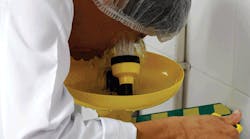Eyewash stations are a staple in facilities that use materials that can cause eye injury or eye infection, providing reprieve after accidental exposure.
But simply having an eyewash station in your workplace isn't enough. Not properly maintaining a station potentially can cause more harm than good and even create its own emergency situation.
Improperly maintained eyewash stations can become a breeding ground for organisms that exist in stagnant and untreated water. Think Legionella, Pseudomonas, Acanthamoeba. And those organisms can infect the worker not only through the water, but also through the skin or through inhalation.
That's why OSHA recommends facilities always follow the manufacturer's instructions for maintaining eyewash stations. The instructions detail when to use specific plumbed systems to avoid microbial contamination. Likewise, self-contained stations also have directions for flushing the system and recommendations on what solutions to use to flush the eyes.
Legionella
Legionella can cause a serious lung infection. Or, if a worker inhales water with Legionella present, there is possibility for contracting Legionnaires' disease, which can be a fatal form of pneumonia.
Pseudomonas
Pseudomonas aeruginosa causes an infection to the eyes, muscles, lungs and skin, and is identified by the green-blue pus surrounding the infected area. If the infection enters the bloodstream, workers can experience fevers, chills, confusion, shock and death.
Acanthamoeba
This organism usually exists in mucous membranes (nose, throat, eyes) and in neurological tissues (brain) without causing harm. However, it does have the potential to create a harmful eye infection – Acanthamoeba keratitis – that can cause eye redness, pain, tearing, blurred vision, light sensitivity and eye inflammation for several days.
